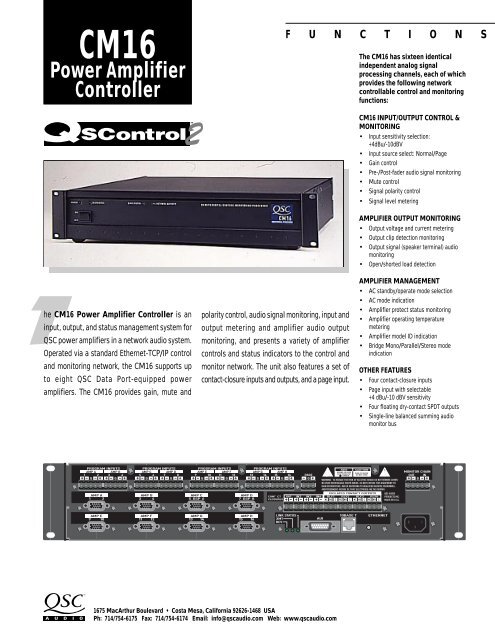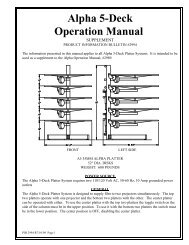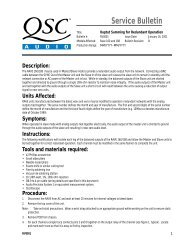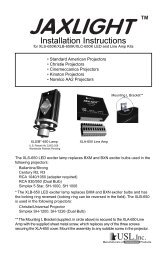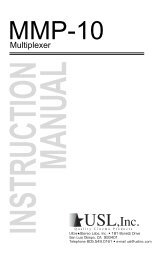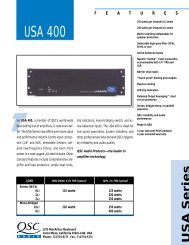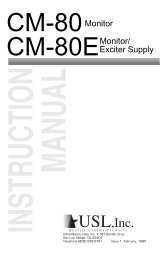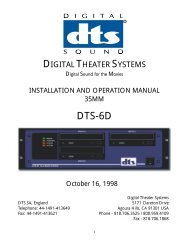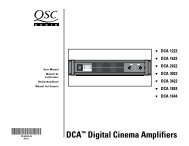CM16 Power Amplifier Controller - R.S. Engineering and ...
CM16 Power Amplifier Controller - R.S. Engineering and ...
CM16 Power Amplifier Controller - R.S. Engineering and ...
You also want an ePaper? Increase the reach of your titles
YUMPU automatically turns print PDFs into web optimized ePapers that Google loves.
<strong>CM16</strong><br />
<strong>Power</strong> <strong>Amplifier</strong><br />
<strong>Controller</strong><br />
F U N C T I O N S<br />
The <strong>CM16</strong> has sixteen identical<br />
independent analog signal<br />
processing channels, each of which<br />
provides the following network<br />
controllable control <strong>and</strong> monitoring<br />
functions:<br />
he <strong>CM16</strong> <strong>Power</strong> <strong>Amplifier</strong> <strong>Controller</strong> is an<br />
input, output, <strong>and</strong> status management system for<br />
QSC power amplifiers in a network audio system.<br />
Operated via a st<strong>and</strong>ard Ethernet-TCP/IP control<br />
<strong>and</strong> monitoring network, the <strong>CM16</strong> supports up<br />
to eight QSC Data Port-equipped power<br />
amplifiers. The <strong>CM16</strong> provides gain, mute <strong>and</strong><br />
polarity control, audio signal monitoring, input <strong>and</strong><br />
output metering <strong>and</strong> amplifier audio output<br />
monitoring, <strong>and</strong> presents a variety of amplifier<br />
controls <strong>and</strong> status indicators to the control <strong>and</strong><br />
monitor network. The unit also features a set of<br />
contact-closure inputs <strong>and</strong> outputs, <strong>and</strong> a page input.<br />
<strong>CM16</strong> INPUT/OUTPUT CONTROL &<br />
MONITORING<br />
• Input sensitivity selection:<br />
+4dBu/-10dBV<br />
• Input source select: Normal/Page<br />
• Gain control<br />
• Pre-/Post-fader audio signal monitoring<br />
• Mute control<br />
• Signal polarity control<br />
• Signal level metering<br />
AMPLIFIER OUTPUT MONITORING<br />
• Output voltage <strong>and</strong> current metering<br />
• Output clip detection monitoring<br />
• Output signal (speaker terminal) audio<br />
monitoring<br />
• Open/shorted load detection<br />
AMPLIFIER MANAGEMENT<br />
• AC st<strong>and</strong>by/operate mode selection<br />
• AC mode indication<br />
• <strong>Amplifier</strong> protect status monitoring<br />
• <strong>Amplifier</strong> operating temperature<br />
metering<br />
• <strong>Amplifier</strong> model ID indication<br />
• Bridge Mono/Parallel/Stereo mode<br />
indication<br />
OTHER FEATURES<br />
• Four contact-closure inputs<br />
• Page input with selectable<br />
+4 dBu/-10 dBV sensitivity<br />
• Four floating dry-contact SPDT outputs<br />
• Single-line balanced summing audio<br />
monitor bus<br />
1675 MacArthur Boulevard • Costa Mesa, California 92626-1468 USA<br />
Ph: 714/754-6175 Fax: 714/754-6174 Email: info@qscaudio.com Web: www.qscaudio.com
<strong>CM16</strong> Specifications<br />
SIGNAL PROCESSING<br />
FREQUENCY RESPONSE:<br />
DISTORTION:<br />
DYNAMIC RANGE:<br />
DATA PORT NOISE FLOOR: -90.5 dBu<br />
INPUTS:<br />
20 Hz to 20 kHz, ±0.5 dB<br />
< .002% THD @ +4 dBu out<br />
>112 dB unweighted (22 Hz-22 kHz)<br />
Program inputs 16<br />
Paging input 1<br />
Monitor bus input 1<br />
Connector type<br />
Phoenix-type detachable barrier strips<br />
Type<br />
Electronically balanced<br />
Grounding<br />
All shield terminals connected to chassis<br />
Nominal level<br />
+4 dBu/- 10dBV selectable<br />
Maximum level<br />
+21 dBu<br />
Inpedance<br />
25 kΩ balanced<br />
Common-mode rejection >75 dB (20-20kHz)<br />
Crosstalk (inter-channel<br />
within Data Port pair) > 75 dB separation (20-20kHz)<br />
Crosstalk (intra-channel<br />
within Data Port pair) > 108 dB separation (20-20kHz)<br />
POLARITY:<br />
In-phase or reversed<br />
PRECISION<br />
ATTENUATOR RANGE: 0 to -86 dB in 0.5 dB steps<br />
PRECISION ATTENUATOR<br />
TRANSIENTS (“zipper”): 86 dB attenuation<br />
OUTPUTS:<br />
Program outputs 16<br />
Connector type<br />
HD-15 female (“VGA” connector)<br />
Monitor output 1<br />
Connector type<br />
“Euro-style” depluggable<br />
Type<br />
Electronically balanced<br />
Grounding<br />
Shield terminal connected to chassis<br />
Nominal level<br />
+4 dBu<br />
Maximum level<br />
+21 dBu<br />
Output impedance 75Ω balanced<br />
Output load<br />
600Ω min<br />
POWER AMPLIFIER OUTPUT MONITORING<br />
OUTPUT SHORT DETECT*:<br />
OUTPUT OPEN DETECT*:<br />
Senses load < 1Ω for Stereo/Parallel<br />
modes; < 2Ω Bridge Mono mode<br />
Senses load > 60Ω<br />
OUTPUT VOLTAGE METER: Range automatically matches<br />
power amplifier model used<br />
OUTPUT CURRENT METER: Range automatically matches<br />
power amplifier model used<br />
POWER AMPLIFIER MANAGEMENT<br />
POWER AMPLIFIER INTERFACE:<br />
Compatibility<br />
Connector & Cable<br />
CHANNELS:<br />
AC POWER CONTROL:<br />
AC Mode Control<br />
Data Port compatible amps<br />
HD-15 VGA cable, 2 meters length<br />
(qualified), maximum length TBD<br />
16 discrete channels<br />
(sufficient for 8 dual amps)<br />
Switches power amplifier between normal<br />
<strong>and</strong> st<strong>and</strong>by mode (only available for<br />
<strong>Power</strong>Light amplifiers)<br />
AMPLIFIER STATUS MONITOR:<br />
Clip indicator<br />
Senses channel clip status<br />
Protect indicator<br />
Senses amplifier protect status<br />
Temperature meter<br />
Reports amplifier operating temperature<br />
(above 50°C)<br />
AC power indicator<br />
Indicates operate, st<strong>and</strong>by, or power-down<br />
mode<br />
Bridge, parallel,<br />
stereo mode sensing<br />
AUDIO SIGNAL MONITOR CHAIN<br />
NUMBER OF SIGNAL<br />
MONITORING<br />
BUSSES PER <strong>CM16</strong>: 1<br />
INTERNAL SIGNAL MONITOR<br />
POINTS (EACH WITH<br />
AN ATTENUATOR):<br />
Pre-fader input signal 16<br />
Post-fader input signal 16<br />
<strong>Power</strong> amplifier output 16<br />
MONITOR INPUT:<br />
Nominal level<br />
Maximum level<br />
Input impedance<br />
Configuration<br />
Common-mode rejection<br />
OUTPUT:<br />
FREQUENCY RESPONSE:<br />
DISTORTION:<br />
DYNAMIC RANGE:<br />
NOISE FLOOR:<br />
Nominal level<br />
Maximum level<br />
Output impedance<br />
Output load<br />
Configuration<br />
GAIN:<br />
Monitor in to monitor out<br />
Control range<br />
Mixed with internal monitor point signal<br />
at unity gain<br />
+4 dBu<br />
+21 dBu<br />
25kΩ balanced<br />
Active balanced, shield connected to chassis<br />
>75 dB 20-20kHz<br />
Sum of Monitor input <strong>and</strong> signals from<br />
internal monitor points<br />
20-20kHz ± 0.5 dB<br />
< .05% THD @ +4 dBu out<br />
> 112 dB unweighted, 22 Hz-22 kHz<br />
-90.5 dB<br />
+4 dBu<br />
+21 dBu<br />
75kΩ balanced<br />
600Ω min<br />
Active balanced<br />
Adjusts amplitude of signal at<br />
each monitor point<br />
0±1 dB<br />
0 to -86 dB in 0.5 dB steps<br />
*Signal level must be greater than -32 dB below maximum output of amplifier
CONTACT CLOSURE INPUTS AND OUTPUTS<br />
INPUTS:<br />
4 discrete inputs<br />
Configuration<br />
Single-ended open/closed contact input.<br />
TTL signal compatible<br />
Resistance for closure detect < 10Ω max<br />
Resistance for open detect > 1kΩ min<br />
Sense current<br />
1.5 mA<br />
Ground limits<br />
Potential to chassis: 3V max<br />
(“-” input terminal) Resistance to chassis: 100Ω<br />
OUTPUTS:<br />
4 discrete inputs<br />
Configuration<br />
Electromechanical relay contacts, floating<br />
Maximum steady-state current 0.5A<br />
Maximum switched current 0.25A<br />
Ground isolation<br />
70V max<br />
CONNECTOR:<br />
Phoenix-type barrier strip module<br />
NETWORK INTERFACE<br />
PHYSICAL NETWORK: Ethernet<br />
Raw data rate<br />
10 megabits per second<br />
Frame format<br />
D.I.X. (Ethernet)<br />
Connectors<br />
(1) RJ-45<br />
(1) AUI<br />
Ethernet types<br />
10BASE-T via RJ-45<br />
Media Attachment Unit (MAU) via AUI<br />
Cable type 10BASE-T: twisted pair<br />
MAU (including but not limited to:)<br />
10BASE-F: optical fiber<br />
10BASE2: 50Ω coax<br />
Cable length 10BASE-T: 100m to hub<br />
(Media dependent) 10BASE-F 5 km<br />
10-BASE2 635 m total<br />
Grounding<br />
floating<br />
TRANSPORT NETWORK:<br />
Internetwork protocol<br />
Transport protocol<br />
APPLICATION PROTOCOL:<br />
GENERAL<br />
HEIGHT:<br />
WIDTH:<br />
DEPTH:<br />
WEIGHT:<br />
MOUNTING:<br />
OPERATING TEMP.:<br />
POWER:<br />
Voltage<br />
Current<br />
Frequency<br />
TCP/IP family<br />
IP<br />
UDP<br />
QSC24<br />
3.5” (2RU)<br />
19” (st<strong>and</strong>ard rack mount)<br />
16.75” plus 1” rear supports <strong>and</strong><br />
1.25” h<strong>and</strong>les<br />
22 lbs. (10 kg)<br />
Rear support recommended for portable use<br />
0 to 50° C<br />
95-135 VAC (US)<br />
1A RMS (US)<br />
50-60 Hz<br />
ARCHITECT’S AND ENGINEER’S SPECIFICATIONS<br />
The <strong>CM16</strong> <strong>Power</strong> <strong>Amplifier</strong> <strong>Controller</strong> shall provide input, output, <strong>and</strong><br />
status control for Data Port equipped QSC power amplifiers in an Ethernet-<br />
TCP/IP based network audio system. Sixteen independent channels shall<br />
be provided, grouped in pairs to support eight dual-channel power<br />
amplifiers.<br />
<strong>Amplifier</strong> Input Control <strong>and</strong> Monitoring. For each of the sixteen power<br />
amplifier input signals, the <strong>CM16</strong> shall provide gain, mute <strong>and</strong> polarity<br />
control, pre- <strong>and</strong> post-fade signal level metering <strong>and</strong> audio monitoring,<br />
<strong>and</strong> selectable +4 dBu/-10 dBV input sensitivity.<br />
The <strong>CM16</strong> shall provide a page input, separate from the normal program<br />
inputs, whose signal may preempt the program signal of any or all of the<br />
sixteen program channels., This input shall have selectable +4 dBu/-10<br />
dBV sensitivity.<br />
<strong>Amplifier</strong> Output Monitoring. For each of the sixteen power amplifier<br />
outputs, the <strong>CM16</strong> shall provide clip detect monitoring, short open<br />
circuit detect, voltage <strong>and</strong> current metering, <strong>and</strong> audio monitoring of the<br />
voltage signal.<br />
<strong>Amplifier</strong> Management. For each of the eight dual-channel power<br />
amplifiers, the <strong>CM16</strong> shall provide AC st<strong>and</strong>by/operate mode control,<br />
AC power state indication, temperature metering, <strong>and</strong> protect status<br />
detection (subject to the capabilities of each amplifier).<br />
Audio Monitoring Chain. For each of the sixteen program channels,<br />
the <strong>CM16</strong> shall provide three monitor points as follows: (1) pre fader<br />
gain control, (2) post fader gain control, or (3) post power amplifier<br />
output. A channel’s monitor output may be selected from one of these<br />
three signals, or it may be switched off. The signal at the <strong>CM16</strong>’s<br />
monitor output connector shall be the sum of the signal at its monitor<br />
input connector <strong>and</strong> the sixteen channel monitor signals. A monitor gain<br />
control shall be provided for each monitor tap point to adjust the<br />
individual levels of the channel monitor signals prior to their being mixed<br />
with the monitor input signal.<br />
Contact Closure I/O. The <strong>CM16</strong> shall provide four trigger contact-closure<br />
sense inputs which shall also be TTL signal compatible, <strong>and</strong> four<br />
dry-contact floating SPOT relay outputs.<br />
Data Network. All <strong>CM16</strong> functions shall be controlled <strong>and</strong> monitored<br />
via an Ethernet digital control network using the TCP/IP transport<br />
protocol <strong>and</strong> the QSC24 control <strong>and</strong> monitoring application protocol.<br />
Rear-panel connections shall be provided for 10BASE-T Ethernet, <strong>and</strong> an<br />
Ethernet AUI (Attachment Unit Interface) connector shall also be<br />
provided to interface with other Ethernet media. Other than the AC power<br />
switch <strong>and</strong> a network media type selector switch, the <strong>CM16</strong> shall have<br />
no manual controls.<br />
<strong>Amplifier</strong> Interface. The <strong>CM16</strong>’s interface to each power amplifier Data<br />
Port shall be via a miniature HD-15 connector. The amplifier interface<br />
shall use a st<strong>and</strong>ard personal computer Video Graphics Adapter (VGA)<br />
CRT monitor cable. This interface shall transmit two amplifier input<br />
audio signals as well as all control <strong>and</strong> monitoring signals. Special<br />
signal conditioning <strong>and</strong> grounding techniques shall be used in this<br />
interface to ensure negligible levels of noise <strong>and</strong> crosstalk.<br />
General. All audio inputs <strong>and</strong> outputs shall be balanced with a nominal<br />
input level of +4 dBu <strong>and</strong> maximum level of +21 dBu. Input connectors<br />
shall be of the “Euro-style” depluggable barrier strip type.<br />
<strong>CM16</strong> Specifications
Processing Architecture<br />
BLOCK DIAGRAM OF THE <strong>CM16</strong>


